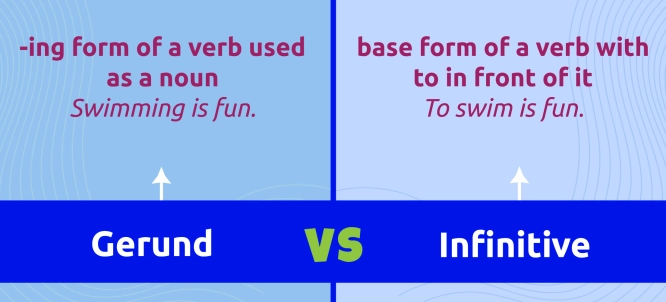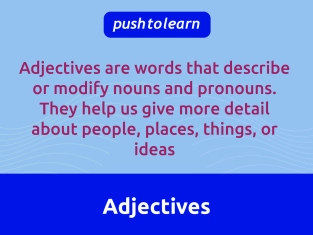by PushtoLearn
Gerundio o Infinitivo en Inglés
Tabla de contenidos
Gerundio o Infinitivo – Ejercicios
Estos ejercicios se enfocan en la diferencia entre gerundios e infinitivos.
¿Qué son los gerundios y los infinitivos?
Gerundio (Verbo + -ing)
Un gerundio es una forma verbal que funciona como un sustantivo. Se forma agregando "-ing" a la forma base de un verbo.
✔ Ejemplos:
Swimming is fun. (Swimming = sustantivo)
I enjoy reading books. (reading = objeto del verbo "enjoy")
Infinitivo (to + verbo base)
Un infinitivo es la forma base del verbo, usualmente con "to" al principio.
✔ Ejemplos:
She wants to travel. (to travel = objeto de "wants")
It’s important to study every day. (to study = complemento del sujeto)

Cuándo usar gerundio o infinitivo
Algunos verbos se usan con gerundio, otros con infinitivo, y algunos con ambos, pero con cambio de significado.
1. Verbos seguidos de un gerundio (-ing)
Algunos verbos siempre van seguidos por un gerundio.
|
Verbo |
Ejemplo |
|
enjoy |
I enjoy playing football. |
|
dislike |
She dislikes waking up early. |
|
mind |
Do you mind opening the window? |
|
avoid |
He avoided answering the question. |
|
consider |
They considered moving to Canada. |
|
keep |
She keeps talking during class. |
|
finish |
We finished studying at 10 PM. |
|
stop |
He stopped smoking. |
2. Verbos seguidos de un infinitivo (to + verbo base)
Algunos verbos siempre van seguidos por un infinitivo.
|
Verbo |
Ejemplo |
|
want |
I want to go home. |
|
decide |
She decided to study abroad. |
|
need |
We need to buy some milk. |
|
learn |
He is learning to drive. |
|
promise |
They promised to help us. |
|
agree |
She agreed to meet at 5 PM. |
|
plan |
We plan to visit Paris next year. |
|
hope |
I hope to see you soon. |
3. Verbos que pueden ir seguidos de gerundio o infinitivo (con cambio de significado)
Algunos verbos pueden usarse con ambas formas, pero el significado cambia.
|
Verbo |
Significado con gerundio |
Significado con infinitivo |
|
stop |
He stopped smoking. (Dejó de fumar.) |
He stopped to smoke. (Se detuvo para fumar.) |
|
try |
Try calling her. (Intenta como experimento.) |
Try to call her. (Haz un esfuerzo por llamarla.) |
|
remember |
I remember meeting him. (Tengo el recuerdo.) |
Remember to meet him. (No olvides encontrarte con él.) |
Gerundio vs. Participio presente – ¿Cuál es la diferencia?
Muchos estudiantes confunden los gerundios con los participios presentes (-ing usado en tiempos continuos).
✔ Los gerundios actúan como sustantivos:
Swimming is good for health. (Gerundio = sujeto)
✔ Los participios presentes se usan en los tiempos verbales:
She is swimming in the pool. (Participio presente en presente continuo)
Gerundios e infinitivos en el inglés cotidiano
✔ En el trabajo:
I need to finish this report by Monday. (infinitivo)
She enjoys working with numbers. (gerundio)
✔ En la vida diaria:
Do you mind helping me with this bag? (gerundio)
He decided to stay at home today. (infinitivo)
✔ En conversaciones:
I stopped drinking coffee last year. (gerundio)
I stopped to drink some coffee before work. (infinitivo, ¡con significado diferente!)
Errores comunes con gerundios e infinitivos
❌ She wants going to the party. → ✅ She wants to go to the party.
❌ I enjoy to read. → ✅ I enjoy reading.
❌ He decided going to the gym. → ✅ He decided to go to the gym.
FAQs sobre gerundios e infinitivos
¿Qué es la forma infinitiva de un verbo?
El infinitivo es la forma base del verbo, normalmente con "to" (por ejemplo: to eat, to run, to learn).
¿Cuál es la diferencia entre un gerundio y un infinitivo?
El gerundio (forma -ing) actúa como sustantivo (I love swimming), mientras que el infinitivo (to + verbo) expresa propósito o necesidad (I want to swim).
¿Cómo sé cuándo usar gerundio o infinitivo?
Algunos verbos siempre usan gerundio (enjoy reading), otros usan infinitivo (decide to go), y algunos cambian de significado (stop smoking vs. stop to smoke).
¿Los gerundios son sustantivos?
Sí, los gerundios funcionan como sustantivos en una oración (Swimming is my favorite sport).
¿Un verbo puede usar tanto gerundio como infinitivo?
Sí, algunos verbos como stop, try, y remember aceptan ambas formas, pero con un cambio en el significado (I stopped smoking vs. I stopped to smoke).
